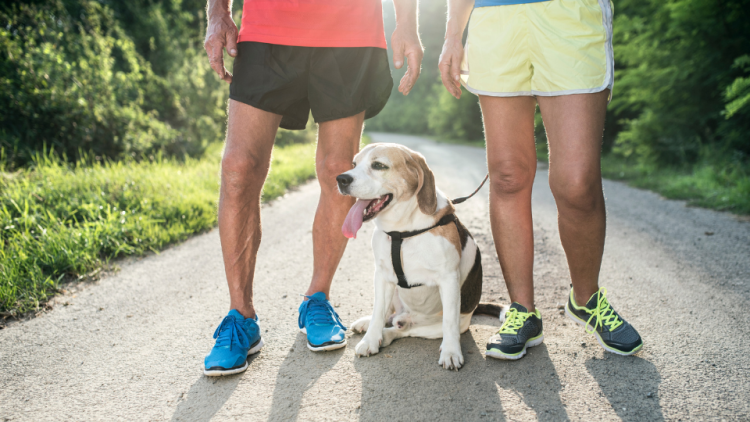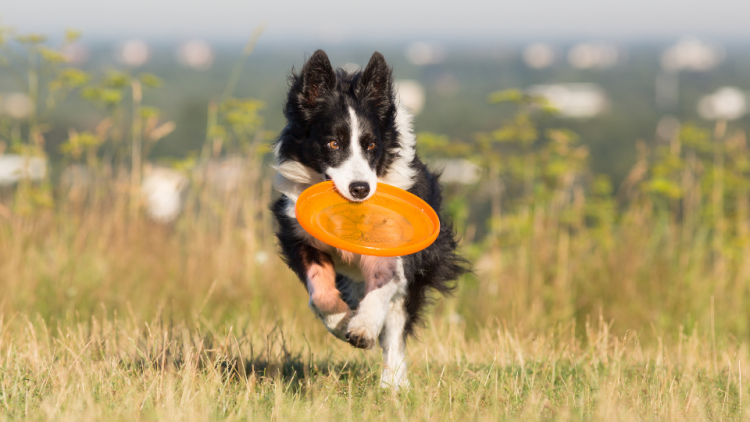We all know that most dogs require daily exercise, but humans also need 30 minutes of activity every day (even though we might like to pretend that isn’t true).
Protect Your Dog's Health With Pet Insurance
Exercising is a lot more enjoyable with a workout buddy, and having a dog presents you with a unique opportunity to get fitter alongside your pooch. If you have a particularly energetic or young dog, this is a little easier to do, as they typically have greater exercise needs — meaning you get more exercise, too! But all dogs can benefit from physical activity with their favorite person. Not only does it help keep them healthy, extending their quality and quantity of life, but it also strengthens the bond you two share.
Need some inspiration on how to work out with your dog? Here are three excellent canine conditioning exercises to burn calories and reach your daily exercise quota.
1) Sprints - Best for Young or Energetic Dogs 2) Hiking - Best for Older Dogs 3) Ultimate Frisbee - Best for Family Dogs
1. Sprints - Best for Young or Energetic Dogs
If you have a spritely dog at home, they’ll love running sprints at your side! Sprinting is a form of high-intensity training that targets cardiovascular endurance. You can do it in any park or backyard (but try to use a contained space to protect your pup’s safety).
What You’ll Need:
- A large outdoor area
- A good quality dog lead and harness
- Comfortable clothing and running shoes
- Water for you and your dog
- A watch or timer (a smartphone works, too)
The Routine
Warm-Up: Warm up your body for at least 5 minutes by power-walking or lightly jogging. A walk or jog to the dog park could qualify as your warmup, so long as it gets your heart rate elevated.
Activity:
- 1st Sprint
Designate a marker to sprint towards, like a trash can or tree. Straight, open spaces without obstacles work best. Run with your dog for 20-30 seconds at a moderate pace, or roughly 50-60% of your maximum effort.
Active Recovery: Walk for 1-2 minutes. This walk doesn’t need to be quite as brisk as your warm-up, but it’s important to keep moving ty lower your heart rate safely.
- 2nd Sprint
Sprint again for 30 seconds using a bit more effort, or 70% of your max speed. Follow this with another active recovery for 1-2 minutes as you catch your breath.
- 3rd Sprint
This time, run with your dog as fast as you can toward the designated marker, or a 20-30 second interval. Extend the duration of your active recovery for a total cooldown period of 2-3 minutes.
Repeat
Ideally, you should repeat these exercises in 3-5 sets for maximum benefits, but take it slow as you first start working out with your dog to reduce the risk of injury. The goal for this dog exercise is about 20 minutes of activity, plus a 5-minute warm-up and 5-minute stretch. Make sure you have water close by to hydrate after each set.

Benefits
- Burn calories
- Improve cardiovascular health
- Strengthen muscles
Sprinting is great for conditioning and easier to approach than long-distance running. Plus, your dog will have tons of fun every time you run towards a marker as if they were chasing their favorite ball.
2. Hiking - Best for Older Dogs
If you or your dog are not quite the spring chickens you used to be, or you just want a calmer way of introducing a new exercise routine into your life, hiking with your dog might be a good fit. Hiking is incredibly popular for good reason: you’re in nature, the views are often incredible, and it’s great for fitness.
The biggest obstacle is finding a hiking location that is dog friendly, so make sure you do plenty of research.
What You’ll Need:
- A dog-friendly hiking location
- Comfortable clothing and running shoes
- A lead and harness
- Water for you and your dog
- Poop bags
- Your phone (in case you need to make any emergency calls)
The Routine
This one’s simple: Find a hiking location, choose a route that suits you and your dog’s fitness levels, and walk. Add intensity by choosing a longer route or increasing the elevation gain. Use sun protection and take water breaks to prevent dehydration as well as heat stroke in dogs.
Benefits
- Burn calories
- Increase endurance
- Improve cardiovascular health
Hiking is a great, low-impact exercise for dogs and people who might be suffering from arthritis or similar mobility issues.
3. Ultimate Frisbee - Best for Family Dogs
Ultimate frisbee is more than just tossing spinning disk through the air — it’s an effective exercise for you and your dog, and it can get pretty intense when played properly! Moreover, it’s tons of fun and the entire family can play to get their daily dose of activity.

What You’ll Need:
- A frisbee
- Loose clothing and comfortable shoes
- Wide, open space for all players
- Water for everyone playing
The Routine
Set-Up: Create two end zones assigned to each team. This is where the frisbee must be caught to gain a point. Your dog will act like a sniper that can capture the frisbee on either side or between the two zones.
Rules: To play, pass the frisbee to your teammates downfield to score points, but be sure to catch it mid-air. If the disc hits the ground, you’ll have to start again. Try to steal it from the other team when you’re on defense to prevent them from scoring. This game involves a lot of running and jumping!
Benefits
- Improve balance
- Improve hand-eye coordination
- Build stamina
Whether you play competitively or just strike up a friendly match, this dog exercise is wonderful for agility.
Get Moving With Your Dog
These are just three of our favorite ways to work out with your dog. There are so many other activities you can try to get your heart rates elevated. Above all, find an activity that you both enjoy and you’ll be more likely to succeed in creating an exercise routine. The best dog workout routine is the one you can stick to!
